check engine CITROEN 2CV 1975 Owners Manual
[x] Cancel search | Manufacturer: CITROEN, Model Year: 1975, Model line: 2CV, Model: CITROEN 2CV 1975Pages: 86, PDF Size: 2.21 MB
Page 5 of 86
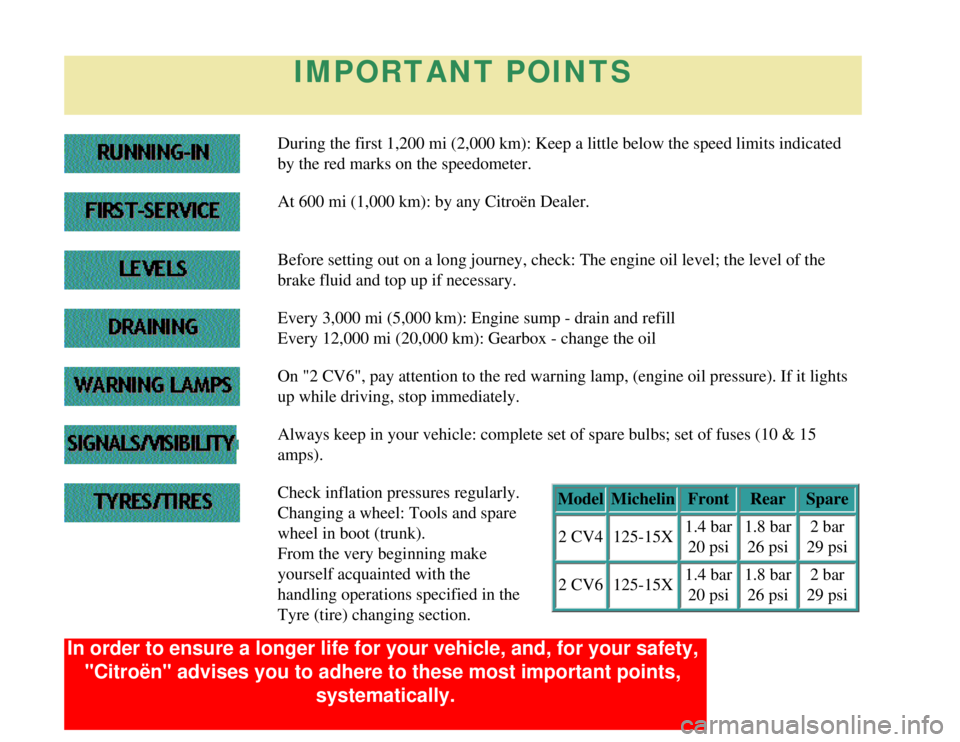
IMPORTANT POINTS
During the first 1,200 mi (2,000 km): Keep a little below the speed li\
mits indicated
by the red marks on the speedometer.
At 600 mi (1,000 km): by any Citroën Dealer.
Before setting out on a long journey, check: The engine oil level; the l\
evel of the
brake fluid and top up if necessary.
Every 3,000 mi (5,000 km): Engine sump - drain and refill
Every 12,000 mi (20,000 km): Gearbox - change the oil
On "2 CV6", pay attention to the red warning lamp, (engine oil pressure\
). If it lights
up while driving, stop immediately.
Always keep in your vehicle: complete set of spare bulbs; set of fuses (\
10 & 15
amps).
Check inflation pressures regularly.
Changing a wheel: Tools and spare
wheel in boot (trunk).
From the very beginning make
yourself acquainted with the
handling operations specified in the
Tyre (tire) changing section.Model
Michelin FrontRearSpare
2 CV4 125-15X 1.4 bar
20 psi 1.8 bar
26 psi 2 bar
29 psi
2 CV6 125-15X 1.4 bar
20 psi 1.8 bar
26 psi 2 bar
29 psi
In order to ensure a longer life for your vehicle, and, for your safety,\
"Citroën" advises you to adhere to these most important points, systematically.
Page 10 of 86
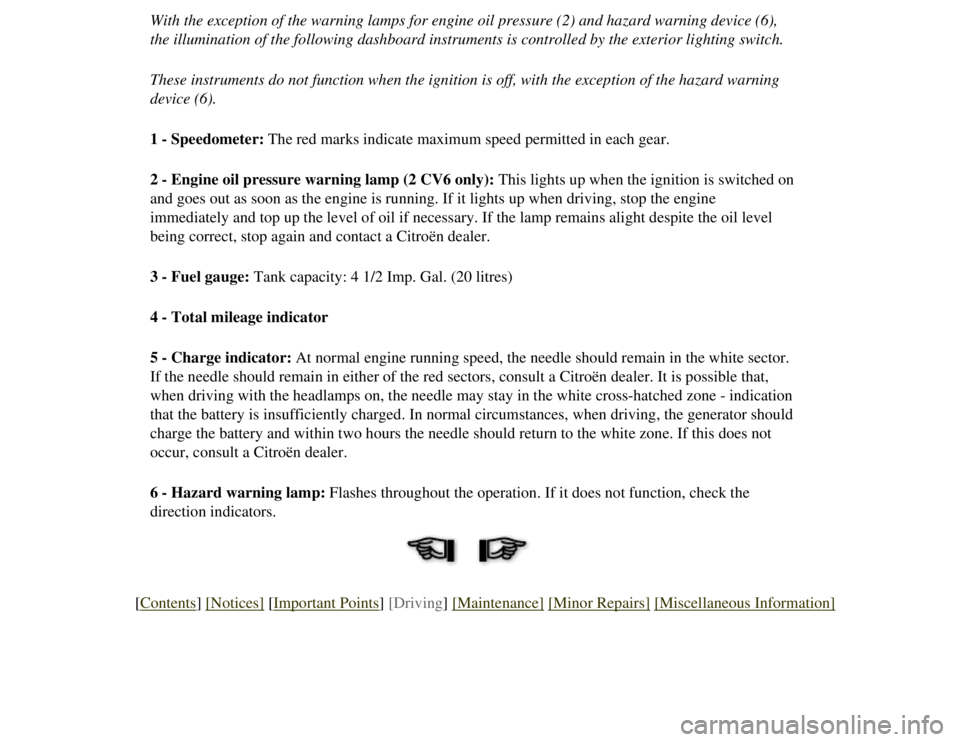
With the exception of the warning lamps for engine oil pressure (2) an\
d hazard warning device (6),
the illumination of the following dashboard instruments is controlled by\
the exterior lighting switch.
These instruments do not function when the ignition is off, with the exc\
eption of the hazard warning
device (6).
1 - Speedometer: The red marks indicate maximum speed permitted in each gear.
2 - Engine oil pressure warning lamp (2 CV6 only): This lights up when the ignition is switched on
and goes out as soon as the engine is running. If it lights up when driv\
ing, stop the engine
immediately and top up the level of oil if necessary. If the lamp remain\
s alight despite the oil level
being correct, stop again and contact a Citroën dealer.
3 - Fuel gauge: Tank capacity: 4 1/2 Imp. Gal. (20 litres)
4 - Total mileage indicator
5 - Charge indicator: At normal engine running speed, the needle should remain in the white se\
ctor.
If the needle should remain in either of the red sectors, consult a Citr\
oën dealer. It is possible that,
when driving with the headlamps on, the needle may stay in the white cro\
ss-hatched zone - indication
that the battery is insufficiently charged. In normal circumstances, whe\
n driving, the generator should
charge the battery and within two hours the needle should return to the \
white zone. If this does not
occur, consult a Citroën dealer.
6 - Hazard warning lamp: Flashes throughout the operation. If it does not function, check the
direction indicators.
[Contents] [Notices] [Important Points] [Driving] [Maintenance] [Minor Repairs] [Miscellaneous Information]
Page 20 of 86

MAINTENANCE
Levels
Checks and Topping up
1 Engine oil dipstick
The engine oil level, which must lie between the ends of the cut-out
on the dipstick, must be checked from time to time between oil
changes and, in particular, before any long journey.
The check should be carried out with the car as level as possible,
after the engine has been stopped for at least 10 minutes.
To top up, add oil without the level going above the top end of the
dipstick cut-out. The length of the cut-out is equivalent to 7/8 imp.
pints (0,5 litre).
2 Engine oil filler pipe
In Summer, as in Winter, use "TOTAL Altigrade GT Spéciale
Autoroute 20 W 40" or "GTS 20 W 50" oil. If "TOTAL" oils are
not available, use equivalent grades of other reputable makes.
In very cold countries (temperatures often lower than -10C (14F),
use "TOTAL Altigrade GT Spéciale Autoroute 10 W 30" or "GTS
10 W 30" oil, or equivalent grades of other reputable makes.
Never use additives
Do not forget to tightly seal the oil filler cap.
3 Brake fluid reservoir
Fig. 32
Engine Oil Dipstick 1 - Maximum2 - Minimum
3 - Oil level reading
Page 41 of 86

RH side and tail lamps
(and rear number plate lamps) Fuel gauge
Direction indicators Windscreen wipers
Alternator field feed
Charging rate indicator
Engine oil pressure warning lamp (on "2 CV 6")
LOWER FUSE BOX (Item B) Green marking (16 A) Blue marking (16 A)
RH dipped beam LH main beam
Red marking (16 A) Yellow marking (16 A)
LH dipped beam RH main beam
REPLACING THE BATTERY (Fig. 46)
Battery reference: 12 V - 125/25 Ah. CEI (or 150/30 Ah. CEI)
Disconnect the battery terminals, always beginning with the
negative one.
Unscrew the two tie-rods of the support frame then disengage the
battery by sliding it towards the front of the vehicle.
Check that the terminals are in the correct position before fitting the \
new battery.
Fig. 46
Battery
1 - Terminals 2 - Tie-rods
Page 56 of 86
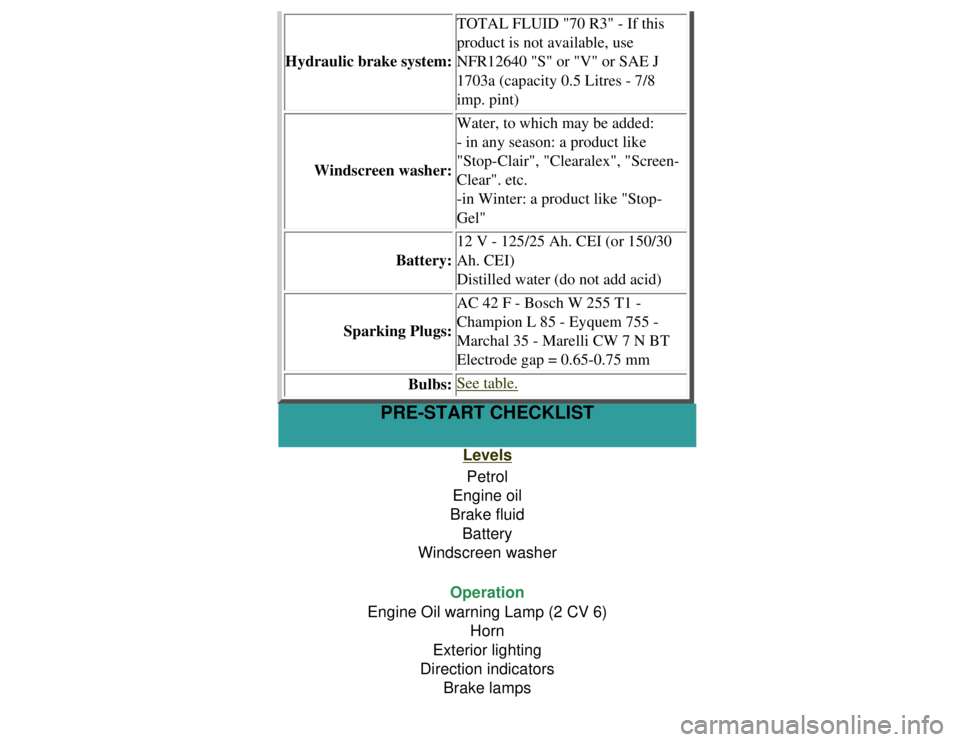
Hydraulic brake system:TOTAL FLUID "70 R3" - If this
product is not available, use
NFR12640 "S" or "V" or SAE J
1703a (capacity 0.5 Litres - 7/8
imp. pint)
Windscreen washer: Water, to which may be added:
- in any season: a product like
"Stop-Clair", "Clearalex", "Screen-
Clear". etc.
-in Winter: a product like "Stop-
Gel"
Battery: 12 V - 125/25 Ah. CEI (or 150/30
Ah. CEI)
Distilled water (do not add acid)
Sparking Plugs: AC 42 F - Bosch W 255 T1 -
Champion L 85 - Eyquem 755 -
Marchal 35 - Marelli CW 7 N BT
Electrode gap = 0.65-0.75 mm
Bulbs:
See table.
PRE-START CHECKLIST
Levels Petrol
Engine oil
Brake fluid Battery
Windscreen washer
Operation
Engine Oil warning Lamp (2 CV 6) Horn
Exterior lighting
Direction indicators Brake lamps
Page 65 of 86
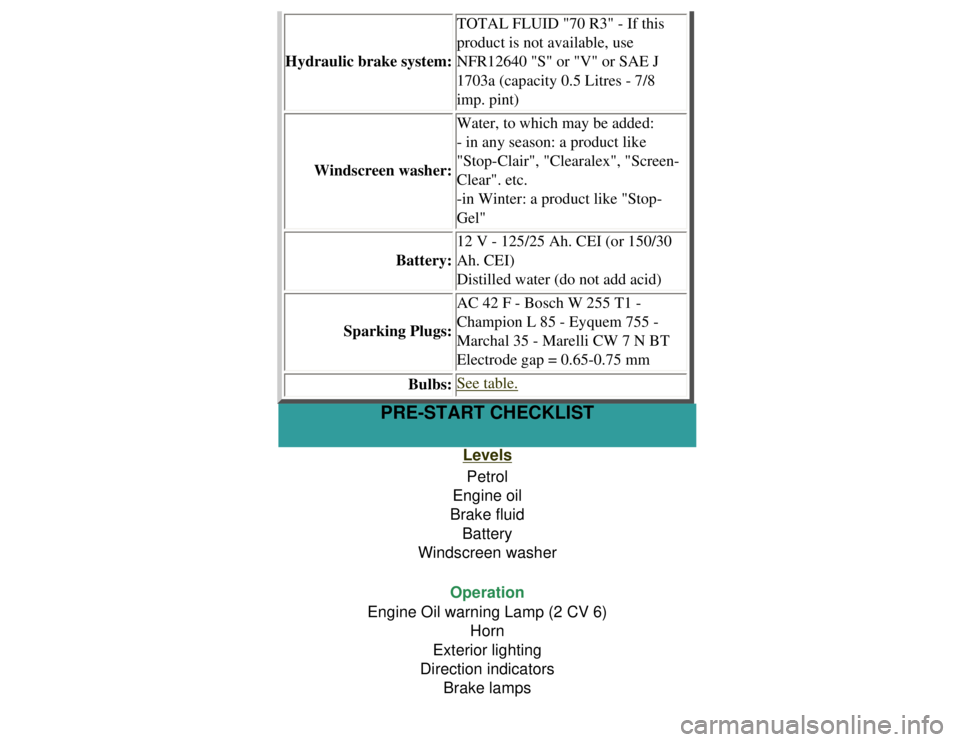
Hydraulic brake system:TOTAL FLUID "70 R3" - If this
product is not available, use
NFR12640 "S" or "V" or SAE J
1703a (capacity 0.5 Litres - 7/8
imp. pint)
Windscreen washer: Water, to which may be added:
- in any season: a product like
"Stop-Clair", "Clearalex", "Screen-
Clear". etc.
-in Winter: a product like "Stop-
Gel"
Battery: 12 V - 125/25 Ah. CEI (or 150/30
Ah. CEI)
Distilled water (do not add acid)
Sparking Plugs: AC 42 F - Bosch W 255 T1 -
Champion L 85 - Eyquem 755 -
Marchal 35 - Marelli CW 7 N BT
Electrode gap = 0.65-0.75 mm
Bulbs:
See table.
PRE-START CHECKLIST
Levels Petrol
Engine oil
Brake fluid Battery
Windscreen washer
Operation
Engine Oil warning Lamp (2 CV 6) Horn
Exterior lighting
Direction indicators Brake lamps
Page 71 of 86
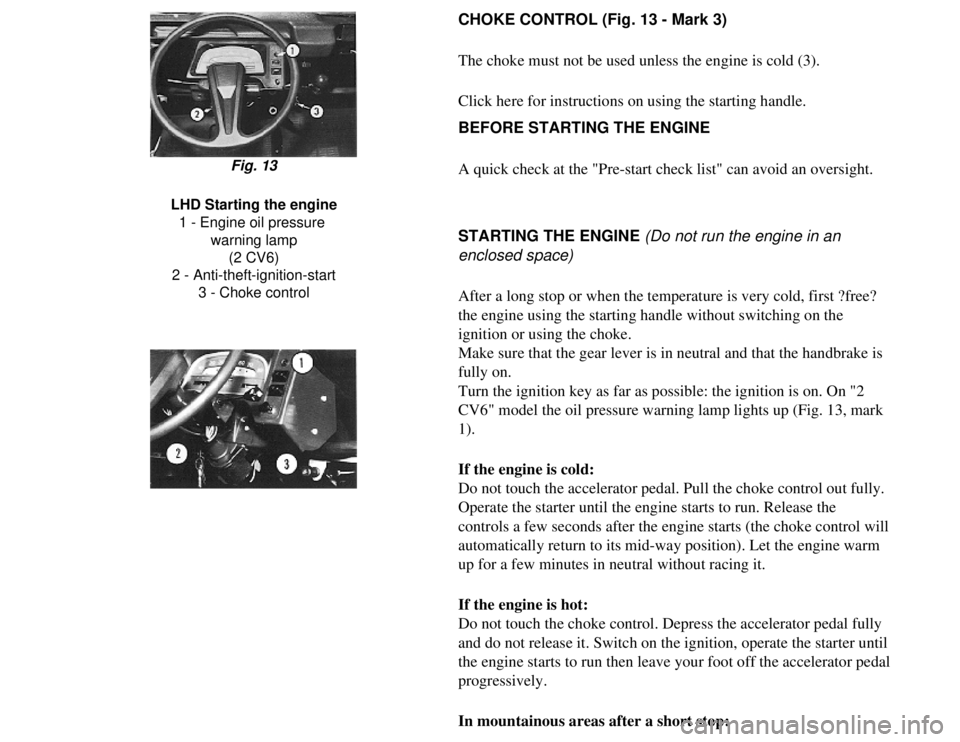
CHOKE CONTROL (Fig. 13 - Mark 3)
The choke must not be used unless the engine is cold (3).
Click here for instructions on using the starting handle.
BEFORE STARTING THE ENGINE
A quick check at the "Pre-start check list" can avoid an oversight.
Fig. 13
LHD Starting the engine 1 - Engine oil pressure warning lamp(2 CV6)
2 - Anti-theft-ignition-start 3 - Choke control
STARTING THE ENGINE (Do not run the engine in an
enclosed space)
After a long stop or when the temperature is very cold, first ?free?
the engine using the starting handle without switching on the
ignition or using the choke.
Make sure that the gear lever is in neutral and that the handbrake is
fully on.
Turn the ignition key as far as possible: the ignition is on. On "2
CV6" model the oil pressure warning lamp lights up (Fig. 13, mark
1).
If the engine is cold:
Do not touch the accelerator pedal. Pull the choke control out fully.
Operate the starter until the engine starts to run. Release the
controls a few seconds after the engine starts (the choke control will \
automatically return to its mid-way position). Let the engine warm
up for a few minutes in neutral without racing it.
If the engine is hot:
Do not touch the choke control. Depress the accelerator pedal fully
and do not release it. Switch on the ignition, operate the starter until\
the engine starts to run then leave your foot off the accelerator pedal \
progressively.
In mountainous areas after a short stop: